Diesen Artikel auf Deutsch lesen
“In the middle of a difficulty lies opportunity.” – Albert Einstein
What could possibly change the work practices of every single organization on the face of the planet, all within the course of a few short months? The latest software or hardware upgrade from Apple? Guess again. Invasion from another planet? We’re not believers in that kind of thing. However, a once-in-a-generation global pandemic would probably do the trick.
“Work Differently. Build the Future” - this is the new tagline for Scaled Agile Framework and we think it speaks perfectly and succinctly to the extensive work that’s gone into SAFe® 6.0. The hard-learned lessons of having a remote or hybrid workforce can be summed up in not too many words - in a nutshell, the Enterprises of today are overrun trying to keep pace with the ever-constant change. It’s no longer the case that only some teams can adopt and work under Lean-Agile practices, it needs to be the organization as a whole.
SAFe® 6.0 - A Full-On Upgrade
We’re not talking enhancements, not an incremental update, not version dot something. This is a full, comprehensive upgrade, with new applications and uses, a new Big Picture (BP), as well as updates to terminology and classifications.
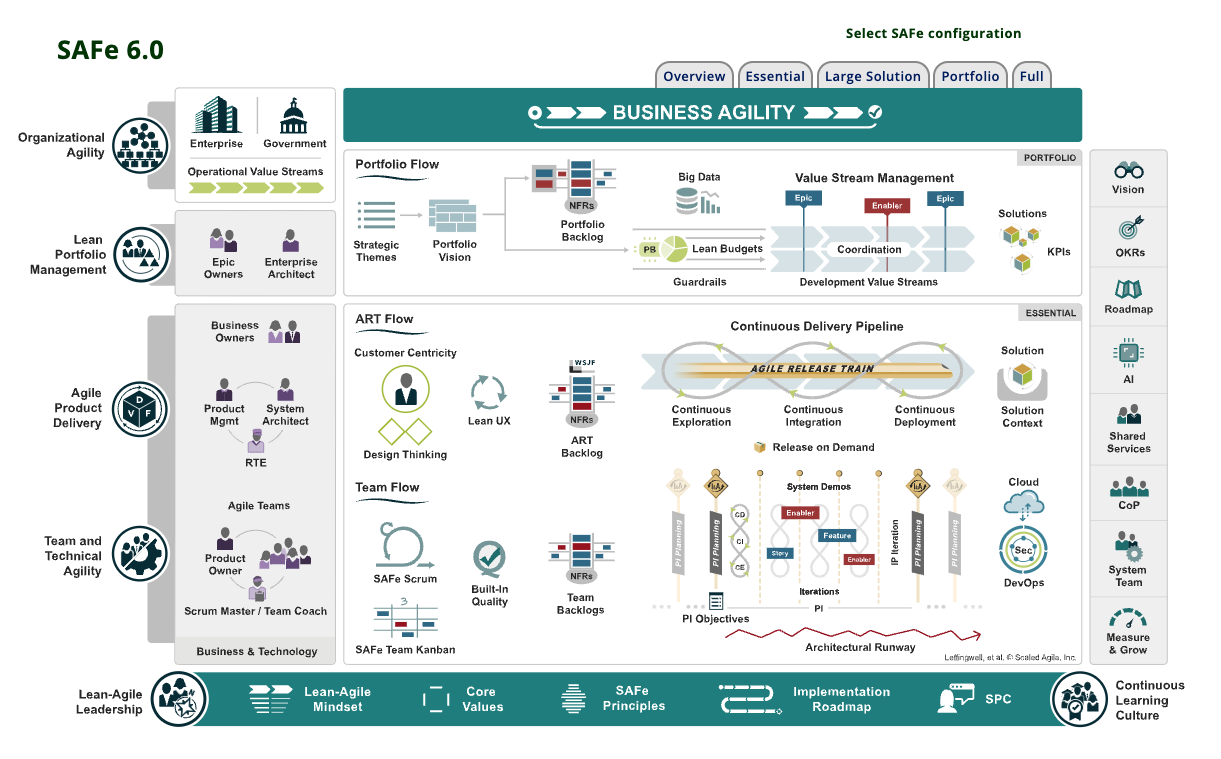
Source: © Scaled Agile, Inc.
To give a snapshot of the foundation that underlies the framework, the good folks at Scaled Agile shared the following graphic:
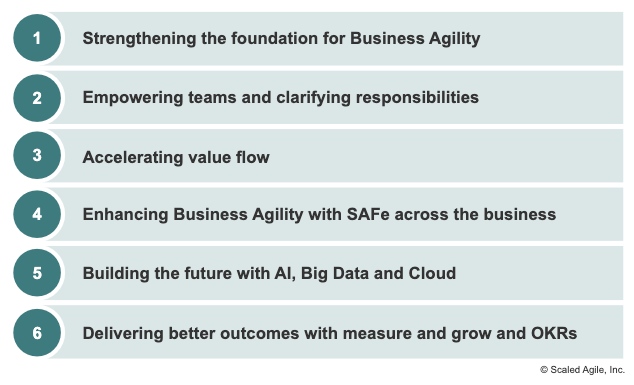
We'll break down each topic for you throughout this article.
Strengthening The Foundation for Business Agility
If you’ve been in the industry for any length of time, you’ve heard a variation of the following phrase uttered quite often; “the rate of change in the digital age is staggering.” Recall Moore’s Law which has moved from a discussion of physical components to a broader discussion on the rate of change of technology in general; Moore's law is a term used to refer to the observation made by Gordon Moore in 1965 that the number of transistors in a dense integrated circuit (IC) doubles about every two years.
Looking at events of the last three decades, there have been significant events where one could easily see this staggering rate of change playing out; the personal computer explosion of the 80s, the Internet explosion in the ’90s, mobile phone adoption in the early 2000s, and in the last decade we’ve seen the deep integration of social media, cloud computing, and artificial intelligence (AI) in our day-to-day lives.
It’s not only that the rate of change in technology has increased in recent years, but also how those changes are embraced so quickly within our professional and personal lives. We’ve simply come to expect, and then become content with, the latest and greatest being released every six months to a year.
In the context of SAFe®, this means Business Agility must be embraced at all levels of the organization, not just to succeed, but to survive. And to better prepare the agile practitioner for this digital transformation, key foundational elements of SAFe® such as Business Agility Value Streams (BAVS) have been dramatically updated and modernized for not only our present situation but in anticipation of the changes to come in the near future.
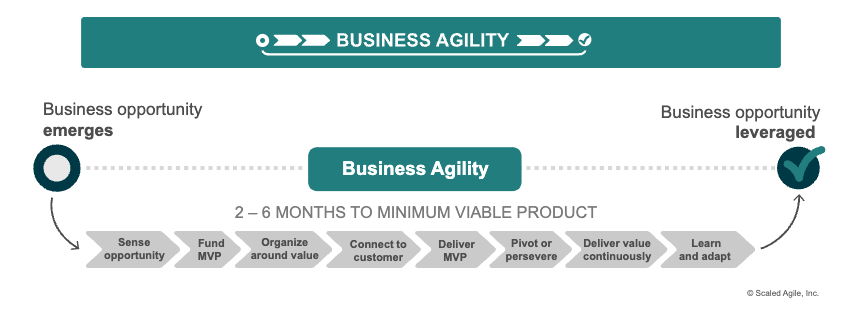
Additionally, dramatic changes were made to the SAFe® Foundation which we’ll explore each in their own article as they really are quite extensive. Suffice it to say, principles such as the Lean-Agile Mindset, the core value and principles of SAFe®, the Implementation Roadmap, even the renaming of “SAFe® Program Consultants (SPCs)” to “SAFe® Practice Consultants” hints at the shift in increased focus and mindset towards pace of change and the need for Business Agility.
Empowering Teams and Clarifying Responsibilities
Think of the “Definition of Done (DoD)” - all criteria have been defined and agreed upon by all parties involved to truly define a project or deliverable as complete. This is done through refinement and the clarification of responsibilities. In the specific context of this article and SAFe 6.0, the roles and responsibilities we’ve come to know have been further refined and clarified and with that come the positive consequences of additional efficiencies, the empowerment of teams and those team members, and overall improved guidance.
As this includes everything from Epic Owners, Release Train Engineers (RTEs), to the Agile Release Train (ART) itself; again, this topic alone could be its own article. For the purposes of this article, let’s take a closer look at the ART and how the responsibilities have been further clarified via a ‘responsibility wheel’;
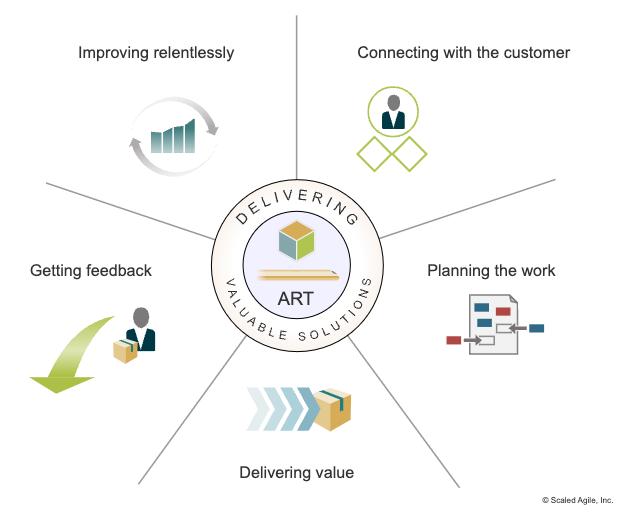
Responsibilities of an ART
Solutions are developed by the ART not with an “all or nothing”, all-at-once approach, but rather, solutions are developed through an interactive process, utilizing a back-and-forth dialogue with the customer to reach a result which has been truly refined and therefore optimized.
Accelerating Value Flow
Continuing the theme of our discussion on the pace and flow of change, version 6.0 of SAFe® identifies and defines the Eight common properties of flow along with “flow accelerators” that further enhance that process;
- Visualize and Limit Work In Process (WIP)
- Address Bottlenecks
- Minimize Handoffs and Dependencies
- Get Faster Feedback
- Work In Smaller Batches
- Reduce Queue Length
- Optimize Time ‘In The Zone’
- Remediate Legacy Policies and Practices
Hand in hand, four new flow articles (Team Flow, ART Flow, Solution Train Flow, and Portfolio Flow) detail how to apply the eight flow accelerators, which are a further expansion of Principle #6; visualize and limit WIP, reduce batch sizes, and manage queue lengths. Each of these flows offers suggested techniques to deconstructing and optimizing issues to help ensure the continuous flow of value at each of those respective levels of SAFe®.
Enhancing Business Agility with SAFe® Across the Business
Not to be cliché, but we feel it’s warranted here - to gain the greatest outcomes from a Lean-Agile transformation of an organization in today’s business environment, it must be a team effort and take place at each and every level of our organizations.
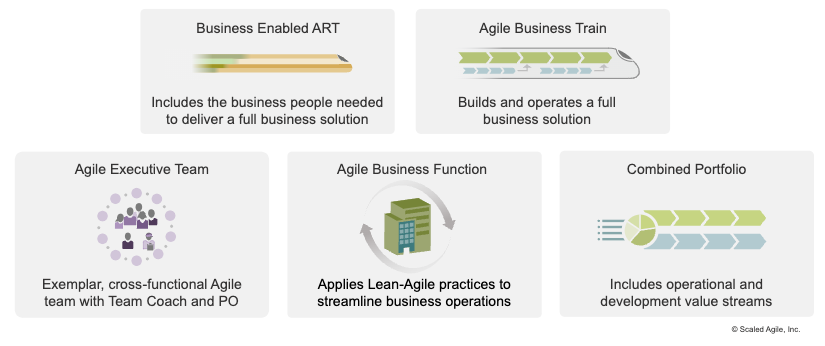
There is an ebb and flow that naturally occurs; where one element of a transformation may be excelling ahead without hiccup, in another part of the organization, that same efficiency will most likely reveal deficiencies in one or others. Extensive work was performed around this topic and five foundational elements that contribute to the idea of “enhancing business Agility” emerged; Business-Enabled ART, Agile Business Train, Agile Executive Team, Agile Functional Department, and Combined Portfolio.
Building the Future with AI, Big Data, and Cloud
If you’re like the author, the following phrase, or any variation of it, has probably been uttered in your presence thousands of times in the last two years alone; “the future of AI is here!” Well friends, seeing how ChatGPT, Large Learning Models (LLMs), Bard AI, Jasper Chat, and the like are now pretty much part of our everyday conversations in our LinkedIn posts and Google Spaces, we’d contend that the future is indeed here.
SAFe® saw the digital writing on the wall years ago and as such, developed a series of guidance articles on these three related topics. Specifically, the articles describe how applying each or all of these will be critical to ensuring that the concepts of “business agility” and Lean-Agile mindset pervade your organization.

Source: © Scaled Agile, Inc.
As this is truly a “moving target”, we foresee additional guidance and reflection on these topics from Scaled Agile in the near future.
Delivering Better Outcomes With Measure and Grow and OKRs
SAFe®’s three measurement spheres - Outcomes, Flow, and Competency - are squarely focused on the measurement of progress toward business agility across all levels of SAFe®. These metrics provide deeper insights into areas of improvement and lend additional data and information in the decision-making process.
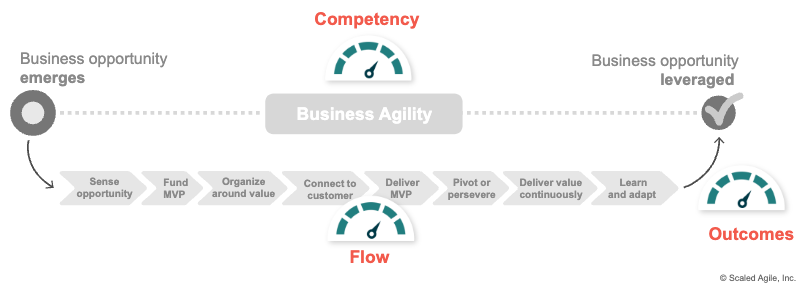
Additionally, Objectives and Key Results (OKRs) were also added to the SAFe® Spanning Palette - that go-to infographic that distills the framework in one succinct image. Use cases for OKRs have been added with the goal of improving final performance results for both customers and the business itself. The three main categories are;
- Enhancing Strategic Alignment Across a SAFe® Portfolio
- Defining Business Outcomes for Epics and Lean Business Cases
- Setting Improvement Goals for the SAFe® Transformation
Further, regarding the backlogs, a Kanban system was added to better manage these issues from start to finish. There was also a standardization of ART, Solution, and other terminology with the goal of improving both the clarity and simplicity of the vernacular. Again, the details are too much to include within this article so we'll discuss this topic later on.
Intrigued? So Are We!
We’ve only scratched the surface. Truly.
An enormous amount of work has gone into the SAFe® 6.0 upgrade and we’ve given you just a taste of what’s involved. Implementing a SAFe® implementation can seem daunting, but it doesn't have to be. Whether you're about to take your first steps or are ready to scale up, we at Agile Hive will be there to help you evaluate and guide you through the process.
If you are looking to integrate SAFe® into your Jira environment, and are interested in learning more about Agile Hive, the “SAFe® in Jira” solution, contact us. We’re anxious to hear from you!
Further Reading
- Is SAFe® Something I Should Consider for my Organization?
- 5 Reasons Why Agile Hive Will Help Your SAFe Rollout with Atlassian Jira
- How to Always Be One Step Ahead with SAFe® and Agile Hive
- 4 Useful Ways to Escape the Time-wasting Loop with SAFe® and Agile Hive
- Tools4AgileTeams 2022 – Skyguide Experience Report: Establishing SAFe in a Highly Regulated Environment
- Tools4AgileTeams 2022 – How SAFe is Modernizing Agile Learning
- Tools4AgileTeams 2022 – Keynote – Agile for the Few or the Many? Achieving Complete Business Agility with SAFe – Dean Leffingwell



